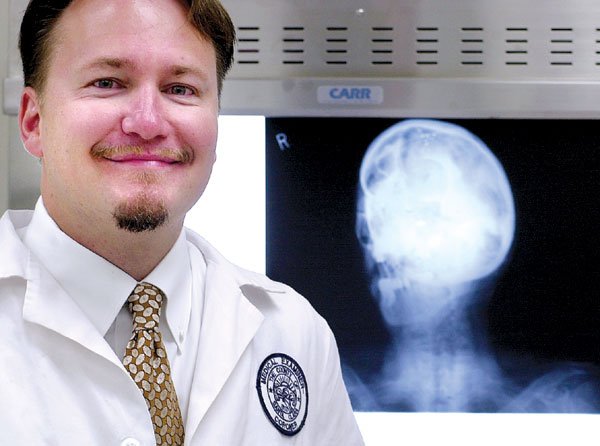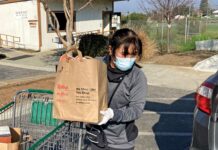Under the fluorescent glare of the medical examiner’s lights,
the man’s remains seemed out of place. He was, after all, still
dressed in his work clothing
– a tan shirt with his name sewn on, denim shorts and black
boots.
Under the fluorescent glare of the medical examiner’s lights, the man’s remains seemed out of place. He was, after all, still dressed in his work clothing – a tan shirt with his name sewn on, denim shorts and black boots. Gardener’s gloves covered in lawn debris still shielded his weathered hands. And though it seemed he might take a breath at any point, he remained frozen, his eyes locked in a hard squint and his teeth gritted around the intubation tube paramedics left in his mouth.
The lone body – that of a 53-year-old with a long scar down his chest, peeking up from the fold of his shirt – lay on a metal gurney, untouched other than for transport. It would be a slow day for Forensic Pathologist Dr. Joseph O’Hara.
“Well, let’s get to it,” he said, gesturing toward the man, who likely died of a heart attack.
When law enforcement officials or a family want answers in the wake of death, they turn to doctors like O’Hara, of the Santa Clara County Sheriff-Coroner’s office. Along with a cavalcade of technicians, interns and volunteers, he searches out the exact cause of death with scalpel, scale and sharpened pencil.
O’Hara is one of five pathologists at the San Jose morgue. Together, they autopsy an average of six bodies per day, but can work through up to 13 in a single shift.
When a person dies, a coroner transports him or her to the morgue, where pathology technicians like Marilyn Ruiz sign in the bodies. Some are in body bags. Others lie covered by sheets. Each is wheeled in, assigned a toe tag and weighed on a large scale pre-programmed to factor out the weight of the metal gurneys. The body is then placed in the morgue’s refrigerator, which can hold up to 280 bodies in cases of emergency thanks to stackable shelves throughout the unit, though to the best of anyone’s knowledge, they’ve never had to use them.
“If they’re really decomposed, they go in the freezer,” said Ruiz, who became a pathology technician when her children left home to attend school. Keen on investigative work like that performed by the FBI, she ended up pursuing the clues held by the human body instead.
On this day, the morgue’s refrigerator is partially filled with bodies awaiting pick-up by funeral homes or burial by community organizations who care for the bodies of those who have no families to bury them. Families seldom visit this place, except to identify bodies.
An 18-month-old who fell from a rope ladder and hit his head lays between a stillborn baby and a middle-aged woman who died from a heart attack.
There are also indigent people and unclaimed babies – those stillborn or abandoned or the like – who are being held until they can be buried, and there’s a bag of clothing from an unidentified man whose skeletal remains were found by hikers.
It’s a tough job that takes a special person to do, said O’Hara.
“Our job is telling a story, their story,” said O’Hara, pointing to the case history of the day’s patient. “We’re the last ones to speak for them, and if you think about it in that context, our job really isn’t that gruesome.”
To keep themselves sane, workers like O’Hara indulge in their own brand of gallows humor.
“We wouldn’t want to disrespect the bodies or the families, but we laugh and we joke during the day,” he said.
Each basic autopsy – where the cause of death is fairly obvious – takes nearly three hours. Most human remains brought in after noon are stored in the refrigerator for autopsy the next day, and people who die late on Friday or over the weekend must wait until Monday for autopsy since the county’s medical examiners do not work weekends.
For the autopsy of the 53-year-old man, technicians, doctors and a group of sheriff’s department employees in training look on. Pathology Technician Marcel Watson strips the man nude to begin the first portion, a visual inspection. O’Hara carefully goes over each section of the body, quizzing interns Jimmy Wang and Victoria Nguyen about the names of muscle groups and the types of injuries the man displays.
“What do you think caused this?” he asked, pointing to a scar that follows the man’s ankle.
Jimmy quickly pointed to the matching scar on the man’s chest.
“It’s where they took the grafts for his bypass surgery,” he responded, accurately connecting the two scars.
When all scars, wounds and visual cues are accounted for, Watson, who is dressed in a rubber apron and elbow-length rubber gloves – creates a Y-incision, slicing from each shoulder to the sternum, then down to the groin.
Some of the sheriff’s employees cringe as the autopsy patient’s skin is peeled back, revealing the body’s muscle structure.
The skin is surprisingly thin, underpinned by a layer of inch-thick, bright yellow fat that sits over a layer of abdominal muscle. Another curtain of fat hangs over the internal organs, insulating them against the elements.
Watson and O’Hara use a rib cracker to separate the bones over the man’s chest, and suddenly a three-dimensional diagram straight out of Gray’s Anatomy appears.
There are the lungs, dotted black from years of either smoking or being exposed to very poor air quality. Below them is the diaphragm, which helps to regulate air intake. One by one, the organs are cut out of the body, weighed and dissected.
O’Hara follows the major blood veins in the lungs, slicing them open with a scalpel to look for blood clots, known as embolisms, that may have killed the man. When each major artery and capillary has been flayed, he uses a knife to section the lung in search of tumors or other signs of disease. There are none, so he cuts a small piece of the lung tissue off and throws it into a fixing solution, then dumps the remaining organ pieces into a yellow plastic bag.
The process is repeated with every major organ while Watson takes samples of stomach contents as well as blood from the veins and heart.
Soon the body’s trunk is nothing more than an open cavern, but the search for answers is not completely over yet.
Watson picks up the scalpel, slicing over the crown of the man’s head from ear to ear. He peels the grimacing face down like a mask, exposing the bare skull, and fires up his saw. Moments later, the top-most portion of the head is separated with a hollow knock, and the brain is quickly dislodged.
It’s a combination of sight and sound that both fascinates and horrifies, finely sketching the fragility of human life. It’s not for everyone.
“Now that all these programs like CSI are out, people are fascinated with the job,” said Ruiz. “When I first started it was like, ‘Ewww. That’s so gruesome. How could you do that?'”
And while queries from people interested in jobs like Ruiz’s and O’Hara’s have skyrocketed, most don’t get past their first exposure to a real dead body.
“It can be pretty revolting,” said Watson. “The body can be infested with insect larva or decomposed. Not everyone looks like their photo ID, especially if they were sitting at home unattended for a few days. A lot of people come to the realization that this isn’t for them really quickly.”
Turnover is low in the morgue, though because most of the jobs require years of experience.
O’Hara, who spent a total of 13 years training for his position, got into the field of pathology during medical school. He didn’t like the odd hours or guesswork of conventional medicine. It all seemed too abstract, but pathology was concrete.
“I liked getting reliable answers, and I’ve always liked law, too,” said O’Hara. “This way I get to do a little of everything. It’s medicine and sometimes scene investigation, plus I get to testify in court.”
It’s a sentiment that’s echoed by the technicians and staff members in the office.
“You pretty well know that this is for you if you’re willing to go that long,” O’Hara said. “When I go home, I turn it off like a switch. If I took it all with me, it would be too much.”














